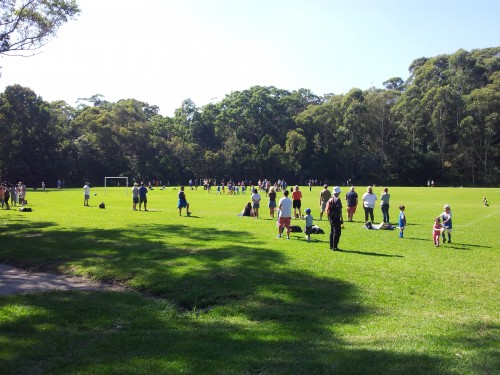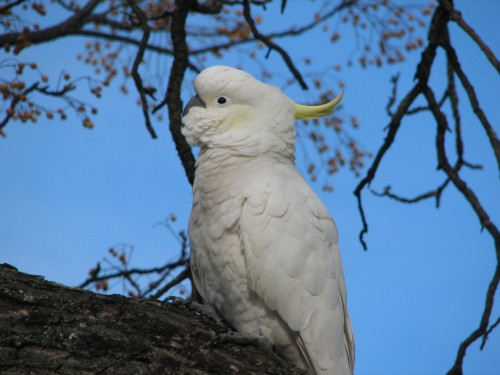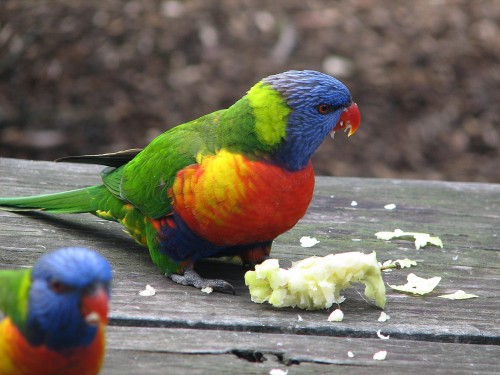A little birding at soccer
We are currently staying with our son and his family in Artarmon, a suburb of Sydney. We try to get over here from Murray Bridge where we live at least once and preferably twice a year. While we are visiting I take every opportunity to do any incidental birding. There are significant differences in the range of bird species present here in Sydney when compared to at home.
On the last two Saturdays, we have had the opportunity to accompany our grandson to watch him play soccer. The photo above was taken with my phone at yesterday’s match. It was held on some pitches in Chatswood West, near the Lane Cove River. The match was a little uneven with my grandson’s team winning 10-0. He scored a goal, hit both upright posts and did a creditable job as the goalkeeper for the second half.
While I managed to mostly keep my eyes on the game from my folding chair, I was aware of some bird activity nearby. There were plenty of Noisy Miners nearby, their constant calling forming a backdrop to the noise of the game. My concentration on the game was tested on occasion when numerous raucous Sulphur-crested Cockatoos came wheeling overhead, landing in the trees surrounding the pitches.
After the game my wife and I found a comfortable garden seat near the playground adjacent to the soccer fields. This area was surrounded by many trees and bushes. While we sat there we were entertained by two Rainbow Lorikeets working at a hollow in a branch of a nearby tree. Within a few minutes a small flock of about 5 or 6 Sulphur-crested Cockatoos came into the same tree, squawking very noisily. The lorikeets vacated the hollow, their protesting screeches making the cockatoos know that they were far from happy. Several of the cockatoos inspected the hollow before leaving it. The hollow would have been too small for the much larger birds.
Other birds seen in the vicinity include:
- Australian Magpie
- Magpie Lark
- Common Myna
- Laughing Kookaburra
- Welcome Swallow
Now for the sad news.
I forgot to take my camera. The above photo was taken with my phone, but taking bird photos requires a much better camera setup than that. Had I remembered to bring my normal camera from home I would have managed to get some great shots of both the lorikeets and the cockatoos. The cockatoos had their yellow crests up on display for much of the time that we observed them. As well as those two species displaying for us, we also had a Laughing Kookaburra flying down to the lawn just in front of us to gobble up a tasty morsel for lunch.
For a moment, I thought I would be able to use my wife’s camera which was in the car. On opening up here camera bag, we found that the batteries were flat, including the spare set. Sigh. We will just have to return there while we are still here. In the meantime, I have included several photos of cockatoos and lorikeets taken elsewhere.
Birding around Gisborne, Victoria
On our holiday earlier this year we stayed for several days with friends in Gisborne, north of Melbourne. I didn’t deliberately go our birding while there but we did go for several drives in the district and I’ll write about those in coming days.
Instead, I took note of those species I saw or heard around the garden and on a walk we did one evening. I was quite surprised by the numbers of Common Mynas now present in Gisborne. I can’t recall ever seeing so many on previous visits. On one occasion there must have been at least 30 sitting on a neighbour’s roof and fence. That is too many!
The town still has large numbers of Sulphur-crested Cockatoos and Long Billed Corellas. Several times I heard a small flock of Yellow-tailed Black Cockatoos flying over. Crimson Rosellas (photo) are also quite common in the area, but I can’t recall seeing or hearing any lorikeets or Galahs on this visit. They must have been around, but I didn’t record any this time.
The common garden birds, apart from the mynas, included House Sparrows, Common Blackbirds, Australian Magpies, Red Wattlebirds and New Holland Honeyeaters. Interestingly, the Mynas seem to have replaced the Common Starling.
I also saw a small flock of thornbills moving through the garden. None would give me a good enough look to positively ID them. They might have been Little Thornbills, but I can’t be sure.
Travelling from Orbost to Gisborne in Victoria
During our holiday in January earlier this year, one of our longest days of travelling was to go from Mallacoota in the far south east of Victoria all the way to Gisborne north of Melbourne. We were on the road all day with just short breaks for morning tea and lunch. There was little time for birding except for those short stops.
After morning tea at Orbost we headed on west towards Melbourne, travelling through picturesque Lakes Entrance and Bairnsdale. I didn’t bother keeping a list of birds seen along the road; there weren’t all that many to see because by mid morning it was getting rather warm. I was hoping to reach Sale for lunch, but we made only as far as Stratford on the River Avon (no -not THAT one – this one’s in Australia). This is Ben Cruachan country but for the second time in little over twelve months, we didn’t have time to call in on Duncan. Pity about that. (Keep the billy boiling, Duncan.)
At Stratford we found a suitable, albeit rather warm, picnic area for lunch. I managed a short list of birds during our short stay, including Common Starling, Willie Wagtail, House Sparrow, Sulphur Crested Cockatoo, Spotted Turtledove and Rainbow Lorikeet. Nothing to get terribly excited about.
Probably the most common birds around were the Common Mynas which seemed to be everywhere. Pity about that.
This whole area is yet another place I’d like to explore further over a week or two, and not just drive through. It wasn’t long before we were scooting along quickly on the freeway heading into Melbourne, then on the City Link and on towards our friend’s place in Gisborne. In all the times we’d travelled this route in recent years, this was the quickest and most trouble free. We actually arrived in Gisborne a little ahead of schedule.
It was a wearying day with long hours in the car and little opportunity for birding. Some days are like that.
Birds in the Sydney CBD
While on our recent holiday in Sydney we went into the CBD on several occasions. One of those occasions was to visit the markets in The Rocks area.
My prime reason for going there was as a tourist, not as a birder. Not matter where I go I have to see what birds are around. That’s just me. I simply cannot ignore the birds. (I’ve even been known to keep a tally of birds seen through the windows at church! Go figure.)
The Rocks area is in the heart of the Sydney CBD, an area rich in history with most buildings being of some historic value. It attracts hoards of tourists and local visitors on a daily basis. Despite the numbers of humans, the bird population flourishes.
Rock Doves (Feral Pigeons) are everywhere. They thrive on food scraps from careless people dropping parts of their lunch in the many eateries in the area. I noticed that some are reluctant to even get out of the way as I walked along.
Silver Gulls likewise are in great numbers and also thrive on human food. Circular Quay with its hundreds of thousands of travellers daily on the ferries on Sydney Harbour is only a few steps away.
Pied Currawongs are also present in the treed areas within The Rocks. This is a species that has adapted to an urban environment and also feeds on human throwaways.
The introduced Common Myna (see photo below) is another species that has become a pest in urban zones and can be found in large numbers throughout Sydney.





